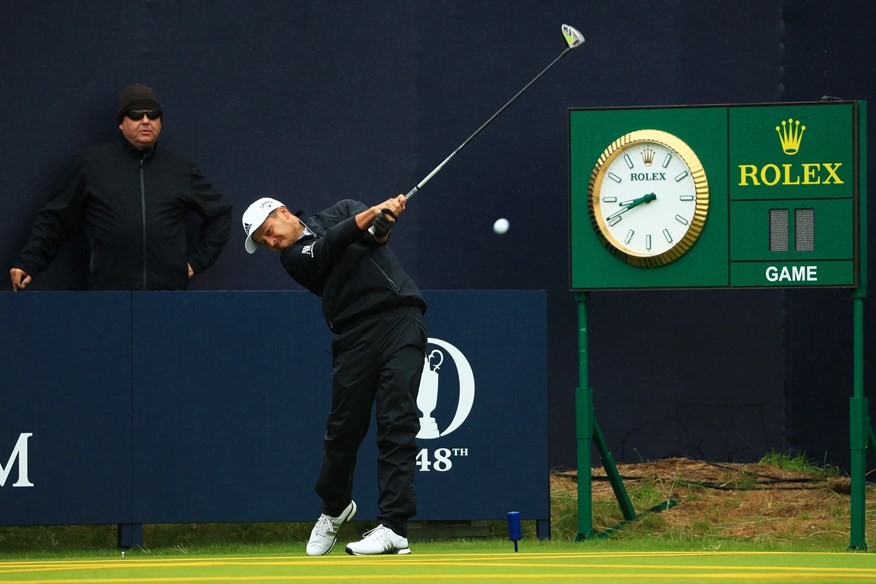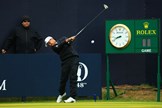Xander Schauffele is first to fail R&A driver test – but his wasn’t the only one
Last updated:
Xander Schauffele is ‘pissed off’ with governing body after he became first person to have their driver deemed ‘non-conforming’ in R&A’s random testing at Royal Portrush. And it turns out his wasn’t the only one
Xander Schauffele had a ‘run in’ with the governing body after he became the first person to fail the R&A’s random driver testing, having been selected as one of 30 players to hand over their club at the start of the week. But while the other players haven’t been named, it turns out his wasn’t the only driver to fail.
Last year’s Open at Carnoustie was the first time that the R&A had conducted their driver test, aiming to determine whether they conformed to the CT ‘Characteristic Time’ limits, but this year marked the first time someone’s equipment had failed.
As a result, Schauffele was left needing to find a new Callaway driver as of Tuesday evening, and visibly struggled during the opening round from the tee.
“They just tested my driver,” said Schauffele after a second round 66. “Yeah, and it didn’t pass.”
Schauffele made it clear he had no issue with the test itself, but felt it was unfair that only 30 players – and not the whole field – had to be tested, arguing that plenty of other players could still be have non-conforming drivers in their bags.
“I had a little bit of run-in with them, because they only test 30 players,” he said. “I thought it was a little bit unfair — I would gladly give up my driver if it’s not conforming.
“But there’s still 130 other players in the field that potentially have a nonconforming driver, as well. Had a word with them and hopefully they take my comments seriously and my concern just because it wasn’t my plan to show up Monday morning of a major or Tuesday — sorry, it was Tuesday evening where I was doing driver testing here. It’s not really what players want to be doing.
“What’s the fair thing to do? Just test the whole field. It’s plain and simple. When I talked to them they didn’t really know how to — you can’t really answer that question. You test everyone, it’s simple as that.
“Other drivers failed. I’ll just say it, I’m pretty sure a (indecipherable) driver failed and a TaylorMade driver failed and the Callaway driver failed. This matter should be private. But R&A didn’t do their job in keeping it private. So I don’t feel like I should — I can tell you right now what happened or what I know.
“The R&A, they pissed me off because they attempted to ruin my image by not keeping this matter private. This is me coming out and treating them the exact way they treated me.”
It left the World No.11 in an unusual position as he was forced to find a new driver that would pass as legal just over a day before the first round of the year’s final major.
Schauffele struggled off the tee in the opening round to a three-over 74 as he hit just 6 fairways (43%), but found a better groove with his new driver on Friday on his way to a six-under 65, hitting 13/14 fairways (93%). On Saturday, he hit 64.29% of fairways.
“I was doing driver testing up until Wednesday. And then yesterday it wasn’t really matching my bag, which was a bummer. I was getting a little upset on the golf course. And today I was testing a little bit on the range again with two different heads. But moved a few weights around and sort of found a good setting, I guess.
“But it is what it is, you know. I have a legal driver now and I sort of put that one to rest and happy to see that ball performing. Like I said it will get better every day.”
Although there was no official statement or news released about Schauffele’s driver, an official – and everyone on Tour – seemed to know about his driver failing the test, which was what put Schauffele in a bad mood.
“An official came up to my dad and asked him, How’s are testing going? My dad, his temperament is a little worse than mine at times. I’m surprised that guy is — he’s a little bigger than I am, too. I’ve got a little more bite but he’s a bit bigger.
“This whole thing was a bit of a stir for my whole team. And like I said, I can deal with certain things if the variables are controlled. But in this situation we’re sort of throw in a nice little hodgepodge, if you want to call it.
“There’s certain moving parts on Tour here and everyone on the grounds knew for some odd reason. So that’s enough to throw me off my game. I can handle it, I’m a big boy. But it was just handled unprofessionally. And it did tick me off, for sure.”
It then transpired it wasn’t just only the R&A that had annoyed Schauffele, but how a fellow player reacted to the news.
“It is an unsettling topic,” Schauffele said. “I’ve been called a cheater by my fellow opponents. It’s all joking, but when someone yells “cheater” in front of 200 people, to me it’s not going to go down very well.
“It was a player out here. I’m cool with him, as well. He thought it was funny…that’s not something you joke about. The someone else is like, I’m chipping around, someone is like, Oh, wedges are legal now.”
Why are they testing drivers?
The R&A and USGA published their 2017 driving distance report back in March last year, and the random testing is all about their continued insights project in to the distance professional golfers hit the golf ball.
CEO Martin Slumbers said last year that there had been an ongoing discussion about the CT limits on a driver, and what happens to it when it wears – something they have been considering for a while.
“Well, one of the discussions that goes on in the equipment world is what happens to the CT or the driver, as it wears,” Slumbers continued.
“That’s some of the questions that we’ve been working on in the new rule book. So as it wears, they generally get nearer to the CT limit, and we wanted to make sure that we didn’t have drivers going out there above the CT limit.”
As drivers get older, they can naturally become weaker, and that in turn can raise the CT limit above the conforming level set by golf’s governing bodies. This will make ball speeds increase as the clubface responds quicker to the ball at the moment of impact – giving players an advantage over their competitors.
Click here to read more about how they driver test – explained by Martin Slumbers in 2018.

